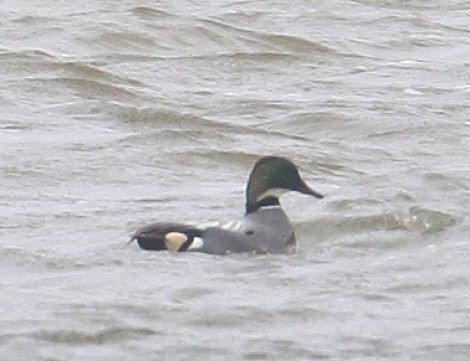Falcated Duck added to Category A of the Irish List.

Introduction
A male Falcated Duck Mareca falcata was found on Cross Lough, The Mullet, Co. Mayo by Dave Suddaby on 2nd April 2012 and was last reported there on 13th April. The bird was accompanying a flock of Eurasian Wigeon M. penelope and was seen to be unringed. It showed no signs of captivity such as feather damage and remained in the centre of Cross Lough with the Wigeon flock.
The identification of this bird was straightforward, however in keeping with the thinking at the time due to an absence of published research into the potential for vagrancy, this record was placed in Category D1 of the Irish list – D1: Species that would otherwise appear in Categories A or B except that there is a reasonable doubt that they have ever occurred in a natural state.
In January 2020 a paper entitled ‘The Falcated Duck in Britain’ by Andy Stoddart and Christopher J. McInerny on behalf of the British Birds Rarities Committee (BBRC) and British Ornithologists Union Rarities Committee (BOURC) was published in British Birds. This paper sets out in detail the history of the species in Britain and the rationale for the acceptance of a male in Norfolk as the first record for Britain and the species added to Category A of the British List. It also details a number of subsequent records that are now acceptable as wild birds.
The Stoddart and McInerny paper details (on behalf of the BOURC) the criteria for acceptance of this species to Category A as follows:
- be fully-winged
- be definitely unringed (unless involving a ringed bird from the natural range)
- behave as a wild bird
- be with an appropriate carrier species (essentially this means Wigeon)
- be at a location frequented by wild ducks (note however, that Falcated Ducks in the Eastern Palearctic can, in addition to natural sites, associate with other ducks on urban park lakes)
- arrive at an appropriate time of year for a vagrant and not linger through the summer.
The IRBC reviewed the Cross Lough bird against these criteria and it was considered that the bird matched all of the criteria namely: it was fully winged and showed no sign of plumage abrasion, it was definitely unringed and this was clearly seen by a number of observers and photographs of the legs confirmed this, it behaved as a wild bird, it was with Eurasian Wigeon it was at a location frequented by wild ducks (Cross Lough) and it appeared in early April (2nd) and stayed until 13th
Considering that all of these criteria were met by this bird it was unanimously accepted onto Category A of the Irish List.
A Falcated Duck recorded in County Wexford in the winters of 2008 and 2009 exhibited some of the acceptance criteria outlined above namely it was in a place frequented by wild ducks (Tacumshin Lake) and was in the company of Wigeon and appeared at the correct season, it was fitted with a very obvious orange spiral ring on its leg and thus did not meet all of the criterial for acceptance as a wild bird. As this is the only known escape, the Committee, while considering the escape issue, did not deem it to be a significant problem in Ireland.
Falcated Duck is a very rare vagrant in Western Palearctic with records as follows; Austria (1839,shot); Bulgaria ( 23 Feb 1978); Iraq (2: 19 March 1916; winter 1968-69); Jordan ( 10 Jan 1969, shot); Malta (10 Oct 1979, shot); Netherlands (13); Spain (3)
Falcated Duck breeds in East Siberia from the Yenisey River and Baikal Region, East to the Sea of Okhotsk and South to North-East China and Hokkaido, Japan. They winter from S Japan to S.E. China, locally west to Nepal The species has also shown an ability to cover long distances east of their normal range with records from Hawaii and circa 7 records between British Columbia and California.
References
Stoddart, A., McInerny, C.J. 2020. The Falcated Duck in Britain. British Birds 113: 44-53 January 2020.
Kemp, J. 2020. Falcated Duck in Norfolk: new to Britain. British Birds 113:44-53 January 2020
Mitchell, D. 2017. Birds of Europe North Africa and the Middle East – An Annotated Checklist, 2017, Lynx
Bacon, L., French, P., and the Rarities Committee 2024. , Report on rare birds in Great Britain in 2023, British Birds 117: 664 – 736, December 2024.
Lees, A., and Gilroy, J. 2021. Vagrancy in Birds, 2021, Princeton University Press
